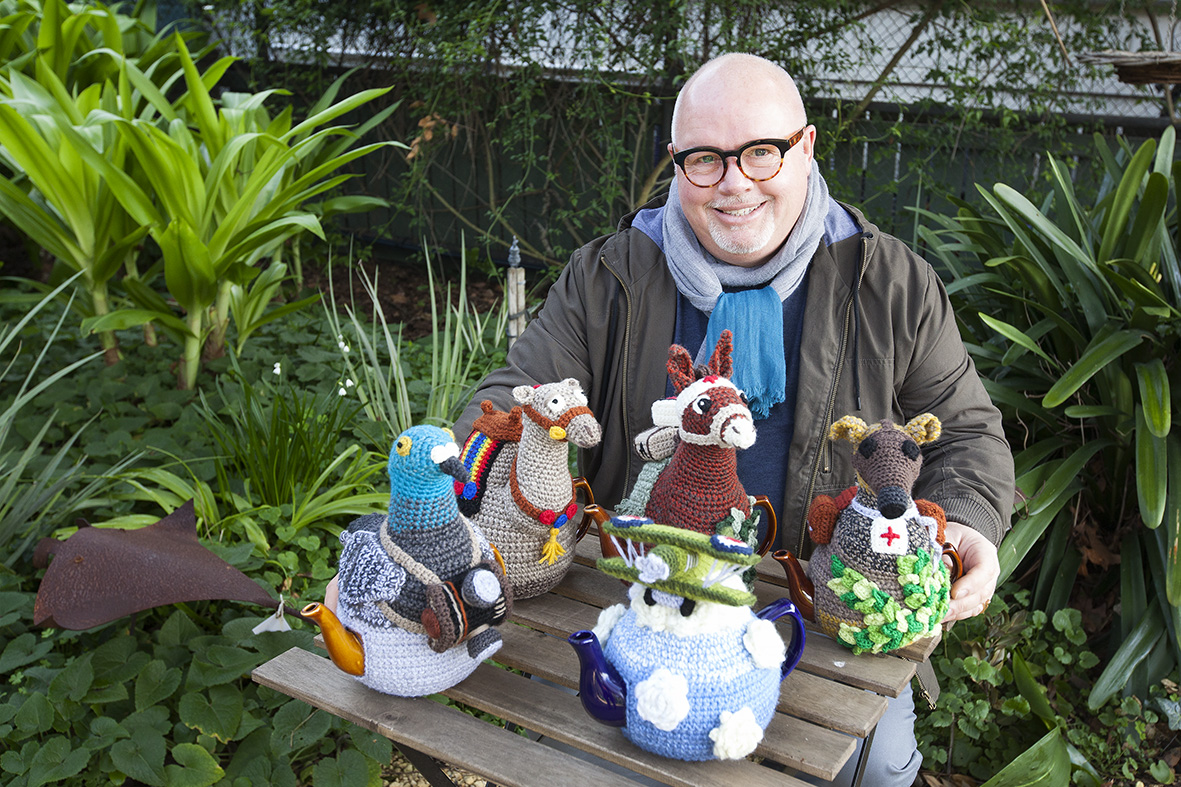Featured in

South Australian textiles artist Trevor Smith has been hooked on crocheting since his teenage years. From Christmas hams to transistor radios, Smith has woven an array of uncanny objects that elicit nostalgia for a bygone domestic world while estranging us from it through the incongruous textures of yarn. Toeing the line between the cosy and the cosseted, Smith’s crocheting expresses his longstanding fascination with the artefacts of memory and family as well as his ambivalence about the past. He spoke to Griffith Review about how he got started, the intricate feats of engineering required by this seemingly homespun craft and his sources of inspiration.
CARODY CULVER: You grew up on a grazing farm in South Australia and you’ve said in past interviews that this was a pretty far cry from the world of fine art. Can you tell me how you learnt to crochet and what drew you to that craft to begin with?
TREVOR SMITH: Well, my mother taught me to crochet and, as you say, I grew up on a farm. I loved farm life but I didn’t like farm work – it was never something of interest to me. And my mother was a very creative person; she was into all sorts of crafts – sewing, knitting, crochet and then all the crazy crafts that came and went throughout the ’60s, ’70s, ’80s and beyond: macramé, tole painting and all that sort of thing. So she was always making stuff and I was always wanting to do what she was doing rather than what Dad was doing outdoors.
When I was in the first year of high school, we had what was termed boys’ craft and girls’ craft. And in the first year all the kids had to do six months of each, so six months of cooking and sewing and six months of plastics, metalwork and woodwork. And in second-year high school I went with the trend and did the woodwork, metalwork and plastics, and I absolutely hated it and was hopeless at it. [I was] terrified of oxyacetylene and all that. In the third year of high school, when I was fifteen, I took what was termed girls’ craft, which was sewing and cooking and enjoyed that a whole lot more – to the point where I topped Year 10 cooking and sewing in 1977 and I was the only male doing it (one of the things I made was a brown corduroy safari suit with flared pants).
So I was, well, not so much an outsider, but pushing against the norm back then.
CC: So it seems that from the start it was a creative outlet for you – would that be right?
TS: Definitely. I was probably doing more sewing than crocheting in my teens but I started out crocheting rugs and cushion covers. I had some younger cousins I was quite close to and I’d make them Barbie-doll clothes, and if someone was having a baby you’d crochet a rug for them. I don’t know if anyone does that anymore, but back in the ’70s it was sort of the done thing. And then for my fifteenth birthday my parents bought me a sewing machine because Mum was sick of me pestering her to use hers.
So that’s where the creativity with textiles probably took off. Not always crochet – crochet was something I had the ability to do, but that I probably left behind for about twenty-five years until I got involved in this project through Regional Arts Victoria in 2009. And that happened purely by accident: at the time in my work I shared an office with the regional arts facilitator for south-west Victoria, who was organising this project. She knew that I could crochet and said, ‘Why don’t you get involved in it?’ So I got involved and that was probably the first time I started crocheting three-dimensional non-functional things and it’s just sort of grown from there.
I had such fun doing the project, which was sort of like organised yarn bombing – you’re familiar with yarn bombing where people sneak in overnight and put all this stuff up? It was a project for a specific area, a swimming hole in a small town outside of Warrnambool, and I created floating waterlilies that went in the pond as well as birds and nests and things that went in the trees – about half-a-dozen pieces. I’ve always found crocheting and working with textiles and any sort of craft work very therapeutic. So I really enjoyed it, I started doing more and more and I’m still experimenting with pushing it to the limits.
CC: When you decide, ‘Okay, I’m going to make, say, a ham on a platter’, do you have to create a pattern for it beforehand? How much planning goes into the creation of something before you actually sit down and start to make it?
TS: There’s no pattern for anything other than saying that with certain elements…for example, I know the little polystyrene balls that I use for grapes or cherries require thirteen stitches around each of them. Or if I’m doing a tea-cosy I know that the arm will be fourteen stitches around. Things like that are not written down but they’re patterns that I repeat with every one. With some of them it’s a bit like engineering (I used to write things down but I don’t anymore): there’s like a planning process that goes into them in sequencing the bits which will be put together or the bits which will be made first.
The ham is a piece of foam rubber which I’ve carved down to a very rough ham shape and then crocheted the cover to go over it. When it’s crocheted and on there and tight, it all looks very neat so you’ve got to plan which end you’ll start crocheting from. With the ham I started at the narrow end and then crocheted up and then I crocheted a large oval place bit that was sewn on to the end of the ham where it’s cut. So there’re things like that that go into the planning of it – which end you’ll start crocheting from if you’re fitting the crocheted piece over a support, whether it be polystyrene or foam rubber or foamcore.
And sometimes, with some of the more complicated things that have voids within them, a lot of planning goes into which bits you stitch together first…there’s a wedding cake that has a platter base and then a layer of cake and then four little columns and then another layer of cake and then a decoration on the top. So I had to think which bits I would sew together first so that I had the easiest access to those last bits to be sewn together. Does that make sense?
CC: It does – it’s like an architectural construction. Finally, what is it about a particular object that makes you think, ‘I would like to crochet that, to turn that into an art object’? Is it something you can’t quite put your finger on or is there something that makes you decide?
TS: I’ve always been interested in history, characters, people, old things. In my last job I was working with an art and heritage collection so I was dealing [with] and handling a lot of old historic objects, but I’ve always been interested in that. I grew up in my father’s childhood home so by the time it was sold in the early ’90s they’d been there over eighty years. My mother’s side of the family were in their house for more than 100 years, so there’s always been history and old stuff around me, like a known history. Both sides of my family are well documented back to the early 1800s; where we came from is an important thing to me. Unfortunately, I sometimes look into it and think, ‘Gee, I wish I didn’t know that!’ but it’s all those sorts of things together.
I’ve been [particularly] influenced by nostalgia for the mid-twentieth century, the ’40s, ’50s, ’60s and ’70s, and what I’ve always been fascinated by – something that’s coming out in the crochet – is images in old cookbooks. You know, like the ham with the pineapple on it? My mother was a fantastic cook, but she was a farmer’s wife and we had fairly basic food growing up. Good food and lots of it but never anything fancy. My parents weren’t people who had dinner parties and tried out fancy recipes with exotic things like pineapple rings or anything like that. I think it’s to do with the colour of the photography too and the style of food. It’s beautiful and hideous at the same time.

Share article
About the author

Trevor Smith
Trevor Smith trained in sculpture before turning to crochet. His inventive pieces reflect his interest in costume, characters, fashion, culture and history.